For the past month and a half, I’ve been staying quiet about the newest iteration of the Springfield Armory Echelon service pistol line. It may not seem like much as far as changes, but they’ve taken a successful design and continued refinement.
They didn’t have to change the optics setup, the Variable Interface System, or the serial-numbered Central Operating Group. And they’ve added additional grip modules to the Springfield Armory Store so you can personalize your heater.
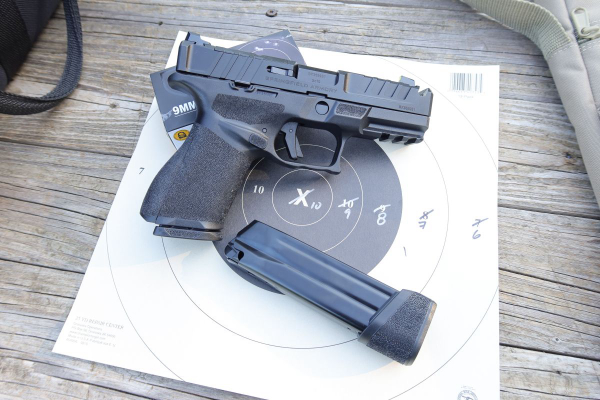
The grip module’s texture extends into the upper area where some bite is critical to keeping the muzzle flat when firing.
All that’s there with the latest installment, including the backstraps. So what’s new? If you read Jim Shepherd’s feature in THE OUTDOOR WIRE first, you know the answer.
The Echelon 4.0C Compact now has an integral compensator port in barrel and slide. While of some value in the Echelon 4.5F, the Compact may have greater use of the port.
While so many will flock to optics on this gun which is built for the addition, I’m enamored of the tritium-front, U-notch rear iron sights. While I was a passable shot with the previous iterations (4.5F, 4.5F-Comp, 4.0C), I may finally acquire the knack of shooting Echelons with this latest model.
My first attempt to shoot the newest model – on the “JaredAF B8-Master” course (reported on here) -- fired with 115 ball didn’t show that. I failed to check zero – in fact these were the first rounds out of the gun -- all hits went high for slow fire. After finding the disparity, the remainder tended left.
I won’t bore you with the miserable scores. Let it suffice to say that folks attending Camp Perry have nothing to worry about.
Using the DeSantis Speed Scabbard (made for the Echelon 4.5F) and Monarch 115gr. ball, I shot my “update” of the first PD qual course I ever shot:
2yd – ICE “bent arm” stage – 6 rounds
7 yd – Fail-to-stop drill (x2); Bill Drill - 12 rounds
15yd – Draw to 4; low ready to 2; draw to 3; low ready to 2; low ready to 1. - 12 rounds
25yd – Draw to 2; low ready to 2 (x2); draw to 2, change hands to 2 more; low ready to 2. -12 rounds
This accounted for 42 rounds total fired on an IALEFI Q bottle pasted on IDPA target backer. I shot a 93%.
Checking ammo later, I found that the gun shot to point of aim at 15 yards with Critical Duty 135gr. FTX +P ammo.
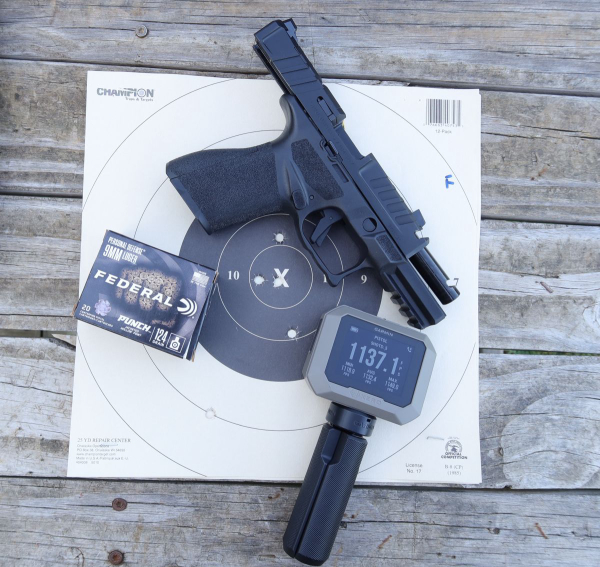
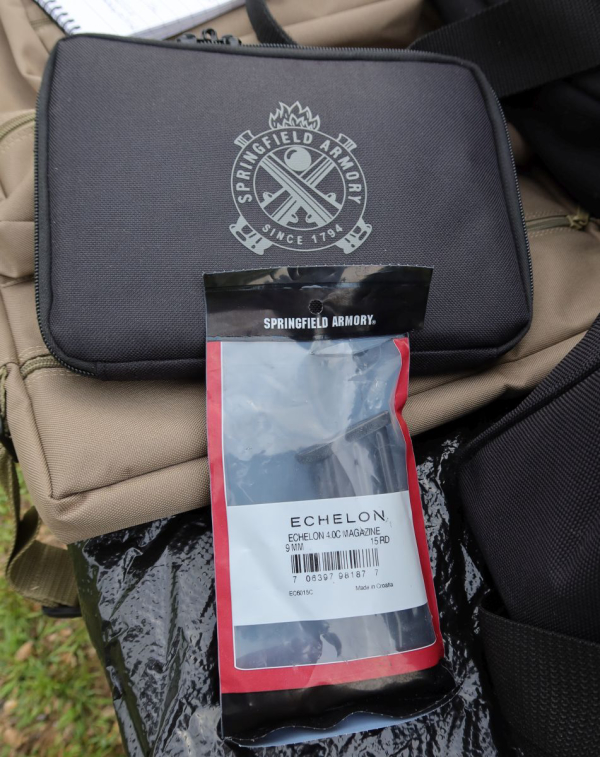
I replicated the part of the velocity check I’d done with the Echelon 4.5F Comp and Echelon 4.0C, using the same ammo (I had some left), in the new gun. As you can see, Critical Duty lost less than 40 fps from the Compact and less than 60 from the full-length comped gun. Federal Punch lost 22 fps from the longer comped gun and 12 fps from the non-compensated Compact.
|
Load |
Echelon Comp |
Echelon Compact |
Echelon Compact Comp |
|
Hornady Critical Duty 135 grain FTX +P |
1,158 fps |
1,136 fps |
1,100 fps |
|
Federal Personal Defense 124 grain Punch |
1,154 fps |
1,144 fps |
1,132 fps |
That’s less than the variation round-to-round for many loads. The Monarch 115gr. FMJ load averaged 1,125 fps.
I contrived to throw a flyer in the group with Federal Punch from 25 yards, making a 2 ½” group into five inches, with the best three hits in 1 5/8”. I was calmer with the Critical Duty load, wrecking a two-inch group. The overall group was 4 3/8”, with three rounds into 1 7/8”.
The Monarch range load put three of five into 2 5/8”.
I used a 6 o’clock hold for all groups, based on my bullseye exercise with the gun.
A few weeks later, between other gun and shooting tests, I got the Echelon 4.0 Compact Comp gun out for another short workout – short, due to the rainfall.
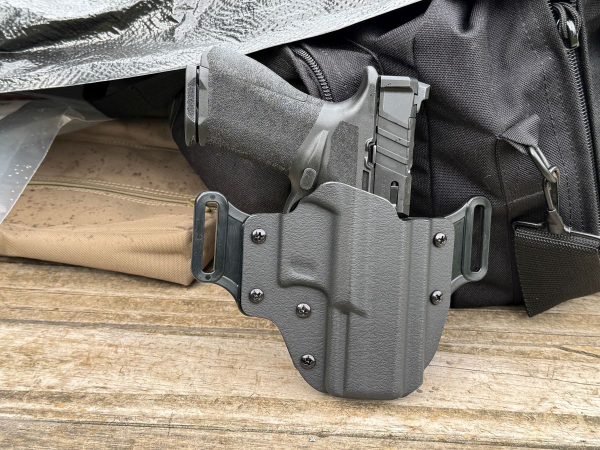
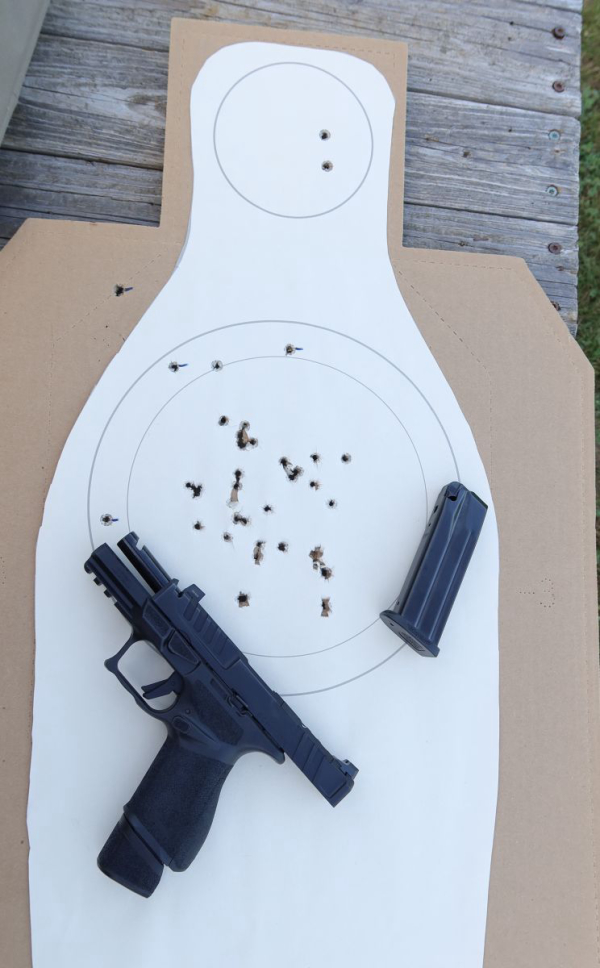
The Echelon works fine in the rain, the comp cut in the barrel and slide notwithstanding.
I had a holster and a pair of fifteen round magazines from the “Store” at Springfield Armory; the fifteen round mags are more appropriate for someone who’d always wear the Echelon 4.0C Comp concealed as opposed to the longer mags with greater capacity.
The holster was an OWB from DeSantis, the Veiled Partner. Kind of a Kydex “pancake” with outriding belt loops, one on each side of the holster, it’s meant to draw the gun in tight so it’ll conceal under a light cover garment.
I put up the 11x17” target, downloaded from First Person Safety, the FPS-1 target. Using the three aiming points on the target, I did a walk-back. At each distance, I fired two rounds for a total of 16 rounds.
Starting at 7 yards, I used the upper aiming point. At fifteen yards, I dropped to the center aiming point, the trademark. As I got past 30 yards, I used the center of the sheet. I ended up with 11 hits out of sixteen rounds fired. The last four – at 40 yards and fifty yards – wandered off the sheet to the left.
The sights, wonderful for quick shooting at closer distances, requires more focus for hits as I move out. Aside from the personal grip issues, I’m sure the gun is easily capable of accurate shooting at distance.
Later, I shot my variant of the ATF qual –
Part of the reason it’s my variant is because of my failure to follow instructions; the other reason doesn’t matter. I found this to be a decent range of pistol drills and my failure to make times (fumbled draw with a relatively unfamiliar gun and a new holster – DeSantis Veiled Partner) was all on me. I used an IDPA target where I taped hits in the “head” box and covered the center of the target with a downloaded target that has both an 8-inch circle and A-zone printed thereon.
Up close I was long on time. At seven yards, I was crestfallen to see I’d gone over on the 3-reload-3 string, until I saw I was .17 second over and I’d done it from the draw -- not from ready as the course called for.
An interesting string is to start chamber empty over a loaded magazine at low ready, seven yards from the target. On the tone, present and attempt to fire; remediate the stoppage and produce five hits, in five seconds. I shot that in just under 4.7 seconds with all hits good. In fact, I kept all hits in until I got to 25 yards where I pulled one left off the repair center.
That’s the second time that happened.
I finished up with the “card trick.” Originally told to me as three seconds from three yards on a playing card-size target from a concealed draw, I had plenty of time but was out of the zone with two out of three rounds.
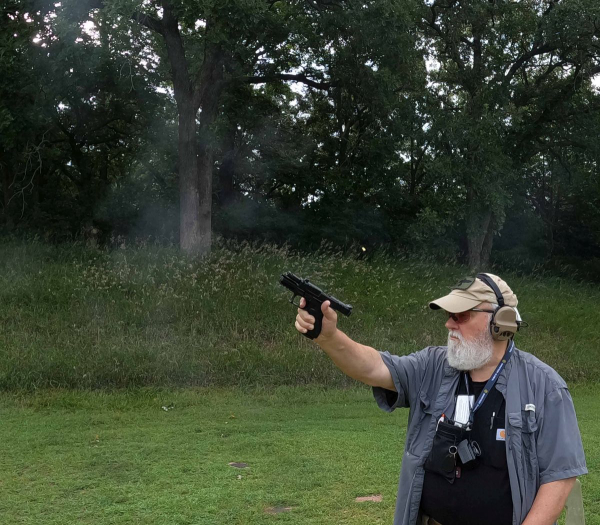
As this is the last centerfire drill of the day, I tried it again. I was actually 12 feet from the target and printed three nearly touching on the card in 2.62 seconds (the first, with misses, was 2.81). I followed up with the five-shot version of the exercise; 3.25 seconds for five, from the concealed holster, all inside the outline of the card.
The gun has been 100% since it arrived.
This thing is a dandy. Before anyone complains that I didn’t mount an optic on the piece, stand by.
It’s not only an optic, but it’s an enclosed optic – so I can be up-to-date.
— Rich Grassi